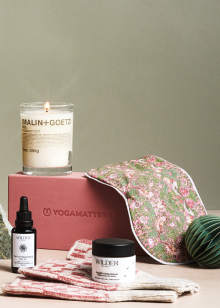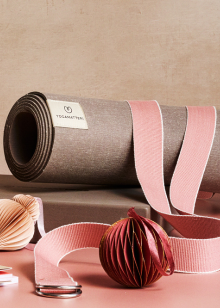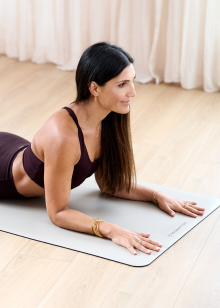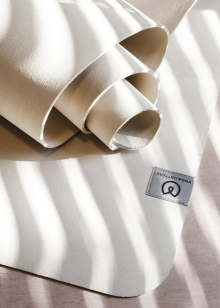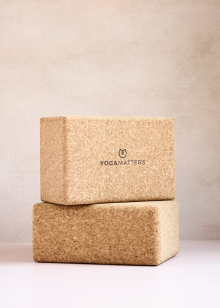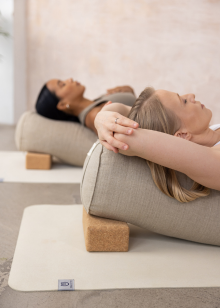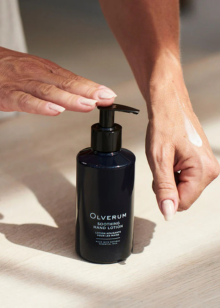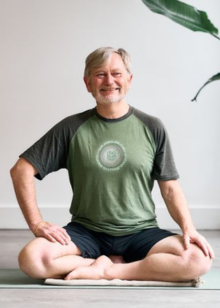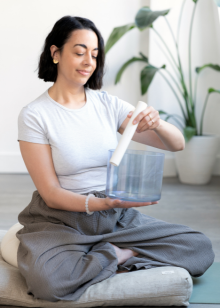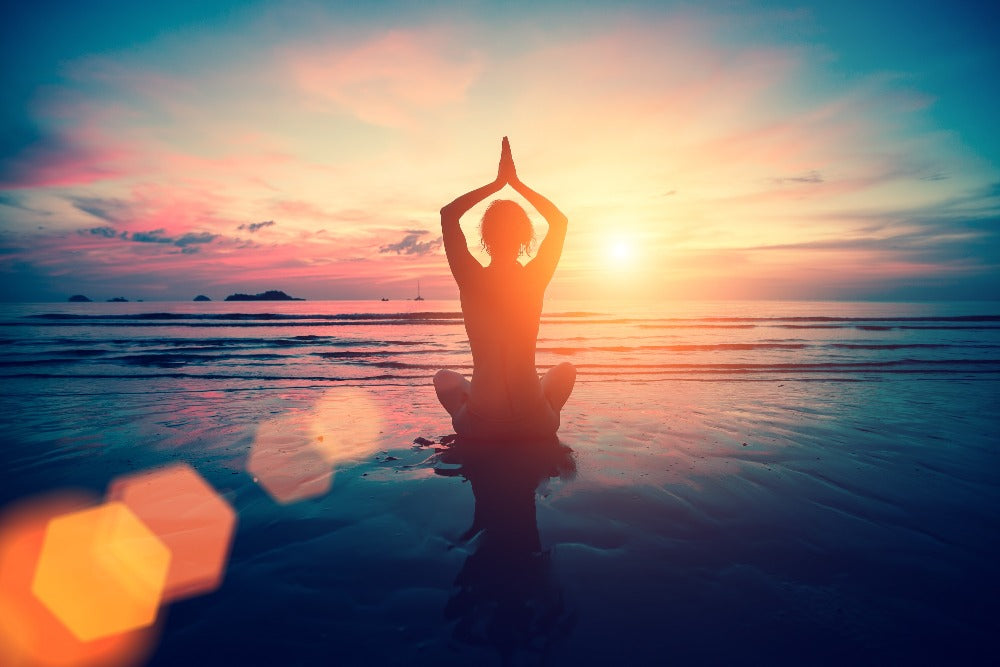Welcome back! If you haven’t read part one we recommend you start at the start as our exploration of the Bandha is not so much sequential as it is cumulative.
We began by considering pada bandha, often considered an accessory to the three primary bandhas, but nonetheless a vital one as our first point of contact (or perhaps we should say conduit) with the earth.
Our next stop is at the mula bandha, located at the perineum. Sometimes specifically described as housed in the ‘levator ani’ muscle (exactly where the name would suggest it is), but more generally in the muscles of the pelvic floor. Mula bandha is inseparable from our muladhara or root chakra, which is anatomically housed in the same area. And much like the muladhara, whose activation begins in the heels, how we engage the entirety of our legs or roots affects the efficacy of our mula Bandha.
When we engage mula bandha, the action is not contained to the pelvic floor, but could perhaps most comprehensively be described as the activation of the lower portion of the deep core/deep front line as described by Tom Myers. (Indeed, we will explore the home of all of the bandha within this deep line and its auxillaries as we progress).
In this way, the activation of mula bandha reaches multidirectionally and intermingles with the mechanisms of Pada Bandha. We feel a lift that begins in our feet and moves up the legs, and a lift that begins in our pelvic floor that moves down them.
Deep Front Line, musculature and junctions.
distal phalanges, flexor digitorum hallucis longus
metatarsals & tarsals, tibialis posterior
medial condyle of the femur, popliteus, and knee capsule
adductor groups (longus, magnus, brevis & pectineus)
ischiopubic ramus, coccyx
obturator fascia and pelvic floor group (levator ani muscles)
So, where can this go awry?
First, let’s deepen our understanding of the term neutrality as it is being used here.
Most importantly we are using the term in a functional and internal sense. Neutral here does not mean that both feet are parallel, but the sensation of the uplift of the active Bandha is central and as such the forces acting around it are neutral. For someone who has a habit of letting their feet roll in, then this may mean that in order to feel the inherent spaciousness and ‘neutrality’ in the joints of the Bandha lifting they may require a specific element of engaged muscular focus, or vice versa, a specific effort to avoid engaging a particularly over-active area.
In fact, the term neutral doesn’t even mean that the feet or legs will be at the same angle. As Paul Grilleys’ amazing bone encyclopaedia shows us it is perfectly possible for our hip joints to be differently shaped (whether by birth or through use) so, for the activation up the left leg to be balanced (resulting in a stable pelvis and thus a complete mula bandha) may be an entirely different thing to the right leg being balanced.
It is also a fluid definition, but not limitlessly so. If we return to our example above with variations between the leg structure it may well be that over time and practice the increased flexibility may bring the legs into an aesthetic balance as well as a senatorial/functional one. However, it also may not and as such an aesthetic end point should never be our goal as practitioners. Different people will have different “end points” and different possibilities, and some people will have the capacity to reach “end points” that are actually way beyond their safe end points. In either scenario if our focus is an aesthetic understanding of alignment we risk damaging our students.
Anyway. Back to our heading:
When our feet are insufficiently stabilised from below, or inadequateluy supported from above we settle into a pattern of either chronic pronation, or supination. Usually limited to the actions of the feet, here I’d like to consider pronation and supination as full body patterns that simply begin at the feet. (Begin here is also a relative term!)
We can consider over pronation as too little resistance to gravity, resulting in a flattening and an internal collapse, as the foot flattens so too does the medial longitundial arch t. Then the base of the tibia, moves down and in, which stresses the lateral knee, and the hips internally rotate as the femoral head moves posteriorly (backwards) resulting in an anterior tilt of the pelvis and increased lumbar curve and compression of the facets of the lumbar spine and sacrum. This redirection will result in a collapse in the inner thigh, groin and pelvic floor with significant effects on our capacity to stabilise the pelvis and limbo-sacral complex. Over time over pronation may also lead to bunions (an enlargement of the bones around the big toe joint), and other stress based issues for the lower leg and ankle such as the ever insidious ‘shin splints’. Unsurprisingly perhaps this pattern is more common in individuals with hypermobile conditions, more flexible connective tissues and naturally lower tone.
It is also worth saying here that what we are describing are broad patterns of potential effects that everyone will fit into a spectrum upon. Some people are born with naturally very flat feet and as a result are significantly more likely to encounter these issues. Some people however have very flat feet but have a great activation up through the legs and never experience any instability in the pelvis. Again, a reminder that what we must assess is function and not aesthetics. A flat footed individual with highly active legs may not benefit from, and in fact may even be hindered by specific exercises to try and train an arch, whereas for another it may be the key stone of their practice.
If pronation is too little resistance to gravity, then supination is too much, as the arch pulls up, rolling the weight to the outer edges of the feet. This “rearing up” continues through externally rotated knees, and thighs. In this case the femoral head is shifted anterioly in the socket resulting in a flattened lumbar curve and a pattern of weakness in the psoas and other deep lumbar stabilisers and over compensation from the hip flexors.
Perhaps the biggest problem with over supination is the spine in no longer able to absorb shock effectively, as this pattern creates a more ‘rigid’ structure. Whereas pronation tends towards a more ‘lax’ structure. Here as the back flattens the pelvic floor is shortened resulting in rigidity, and a loss of the stabilising trampoline of the pelvic floor and mula bandha. (A word of warning here for over/indiscriminate use of the “tailbone tuck” to stabilise the core – more on this later!)
Over-pronation tends to lead towards ankle sprains, and specifically damage to the ligaments on the outer aspect of the ankle. Shin splints again are common as stress through the ankle and lower leg is not effectively spread, yet the shortness in the sole of the foot also predisposes individuals to stubborn and painful conditions such as plantar fasciitis.
Most frustratingly of all for the intrepid practitioner is that it is entirely possible to experience both at the same time with one leg tending towards one pattern and vice versa, leading to a variety of issues from leg length discrepancies to torsion of the pelvis and sacro-illiac joints.
So then, back to mula bandha itself… and how to find ‘neutral’ when neutral moves.
Mula bandha can be a little more delicate to explain then pada bandha, with some of the more colourful I’ve heard including “imagine you are sucking a golden egg into your vagina.”, or “imagine your are having a pee and you want to stop halfway through.” (if you’ve been practicing yoga for some time i imagine you also have heard your fair share!).
However, for me, the central and essential element is the sense of spaciousness or ‘neutrality’ that emerges around the bandha. The pelvic floor lifts, and we experience that upward doming sensation, and then everything around it falls into line. We feel a little taller, a little lighter through the lower back, and everything that was gripping around our hips and our sacrum softens its grip (and however we portray it we do need to be a little careful when we are using the term mula bandha that it speaks equally to men and women as often male practitioners don’t think the term pelvic floor applies to them!)
The sensation of spaciousness in the pelvic basin is equally matched by sensations of the weight simultaneously bearing down through the corners of the feet whilst lifting through the inner lines of the legs. There is a tangible and cyclical feeling of a current of energy AND it is this sensation that matters. None of the bandha are achieved by a specific muscular action, as the demands of the asana change then the activation necessary to create that sense of neutrality around our central column will also change, yet the bandha eventually become a constant. A lightness, a spaciousness, a constant unbroken and fluid connection with our core.
So… lets try applying these extra points in some postures:
Take a moment in tadasana as we did last time. Sense each toe, your feet, your knees, your hips. Let your weight rock from heel to toe, from outer to inner edges. Then create that simultaneous sense of spreading softness and upward suction.
Now, go through your usual warm up. Perhaps a few rounds of surya namaskar as we will be exploring some larger movements.
Firstly, come into your usual standing forward fold. Take a few rounds. Notice how you move in, what happens as you progress through the transition and perhaps also where you reach your end point. Notice perhaps that as you reach this end point the inner edges of the heels want to lift.
Now, deliberately but very softly ground through the inner edges of the heels and track it up to the subtle internal rotation it creates at the thigh. The front crests of the hips will move a little closer together and the sit bones will spread apart, this will encourage a slight anterior tilt to the pelvis and sacral nutation (the top of the sacrum nods forwards) leaving us with an increased lumbar curve. Let your mula bandha lift so that as the pelvis moves forward the lower spine stays long. Try your forward fold again with this activation. Hopefully there is a sense of maintaining the natural, neutral length of the spine with a greater support from the combined actions of our first two Bandha.
Perhaps a little surprisingly, yet for a different reason this stance will also greatly support your backbends! In this instance by activating the lower portion of the gluteus maximus (right down by the sit bones), and by creating space around the sacrum and lift in the lumbar spine. It is common as we backbend to allow ourselves to “splay out” in a pattern of supination yet this action ensures we remain balanced or “neutral”.
However in standing poses such the opposite is true with the posture placing more force into the patterns of pronation. So, here to bring our focus to the outer edges of the feet will encourage a counterbalancing external rotation in the thighs, a lift in the hip crests and a narrowing of the sit bones. Facilitating the engagement of the lower abdominals and pelvic floor and creating space onwards and upwards in the spine.
Enjoy exploring these ideas in your practice and join us again soon as we continue exploring this progression with the rarely mentioned “swadhi Bandha”. For now we’ll leave you with our favourite Malay proverb “A tree with strong roots laughs at storms.”

